
Browse an alphabetical list of artifacts from the Holocaust and World War II. Each object tells a story about the history and demonstrates human experiences during the time period.
<< Previous | Displaying results 11-20 of 233 for "Artifact" | Next >>
Antisemitic propaganda flyer comparing Jews to diseases. It reads "Tuberculosis Syphilis Cancer are curable ... It is necessary to finish the biggest curse: The Jew!"
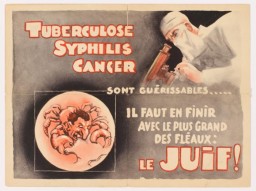
Identifying armband worn by Pao Chia member. In 1942 the Japanese in Shanghai established self-policing units, Pao Chia, composed of all men, foreigners and Chinese, aged 20 to 45. In the designated area, male refugees served several hours weekly in rotating shifts as guards for buildings and ghetto entrances where they examined passes. Despite the Japanese use of the Pao Chia to help police the ghetto, it was relatively easy to leave the "designated area," which was not walled in. Individuals who did so,…
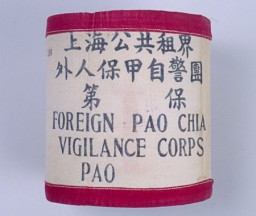
Stanislava Roztropowicz kept a diary from 1943-1944. In it, she describes her family's decision to hide an abandoned Jewish girl, Sabina Heller (Kagan). Sabina Kagan was an infant when SS mobile killing squads began rounding up Jews in her Polish village of Radziwillow in 1942. Her parents persuaded a local policeman to hide the family. The policeman, however, soon asked the Kagans to leave but agreed to hide baby Sabina. Her parents were captured and killed. Sabina was concealed in a dark basement,…
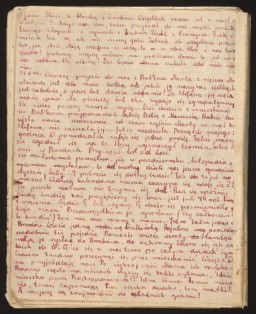
This tan backpack was used by Ruth Berkowitz to carry her belongings as she fled from Warsaw via Lithuania and the Soviet Union to Japan. Most of her possessions were confiscated by both the Nazis and the Soviets during her journey. [From the USHMM special exhibition Flight and Rescue.]
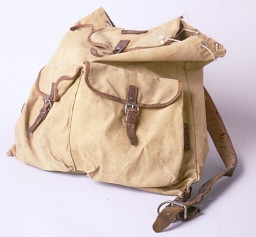
These tiny black, white, gold, and clear glass beads were used by Rachel “Chelly” de Groot from November 1942 to April 1944 and recovered by her brother Louis after the war. Chelly used the beads to make handicrafts. On November 16, 1942, Chelly, then 15, Louis, 13, and their parents Meijer and Sophia left Arnhem and went into hiding after the Dutch police warned them of a raid. Meijer and Sophia hid in Amsterdam while Chelly and Louis moved around to different locations. In summer or fall 1943,…
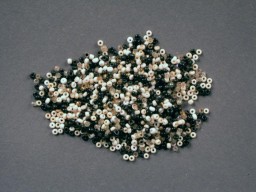
(Middle, left and bottom) In the drawing at the middle, left, Hungarian soldiers use an ax to cut up a dead horse in order to get meat to sustain themselves. The image at the bottom, titled "The Long Trip, February 1943," shows a Hungarian soldier walking along a road past a dead horse and an abandoned harrow that is half buried in the snow. [Photograph #58110]
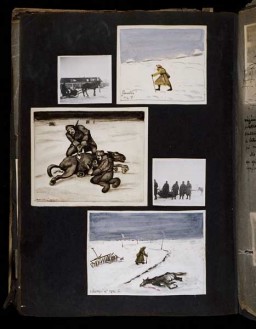
(Top) A drawing dated October 1942 depicting the events of August 28 when Beifeld was wounded near the front lines. His caption reads: "I get wounded and manage to get away from the dangerous bend in the [Don] river]." (Bottom left) Skull of a Soviet soldier with the caption 'Keep Smiling.' (Bottom right) Map entitled 'Dangerous Curve' depicting the bend in the Don River where the Soviet army was threatening to break through. [Photograph # 58061]
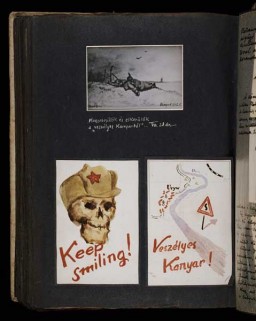
(top) "Watercolor entitled 'Partisan hotel and public house', Krassnolipia, Ukraine, until July 31, 1942"; (middle) "Drawing entitled 'The interrogation of partisans captured by our unit'"; (bottom) "Watercolor entitled 'My lodgings in Krassnolipia'" [Photograph #58040]

(Bottom) A drawing illustrating the patriotism of the Hungarian Jewish Labor Serviceman. Despite the fact that the Jew is denied the right to wear a military uniform and bear arms, Erno Steiner picks up the abandoned machine gun of First Lieutenant Hevessy of the 4th Infantry Division and starts firing at Soviet troops to fend them off. [Photograph #58015]
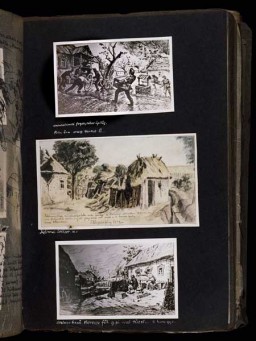
(Top and bottom) The image at the top shows Hungarian soldiers abandoning their trenches on the front lines as a Soviet tank overruns the barbed wire fortification separating the two armies. The drawing at the bottom captioned "Alarm," shows Hungarian soldiers running back and forth sounding the alarm of the Soviet counteroffensive. The drawings are dated Jan 11 and 13, 1943. [Photograph #58103]

We would like to thank Crown Family Philanthropies, Abe and Ida Cooper Foundation, the Claims Conference, EVZ, and BMF for supporting the ongoing work to create content and resources for the Holocaust Encyclopedia. View the list of donor acknowledgement.